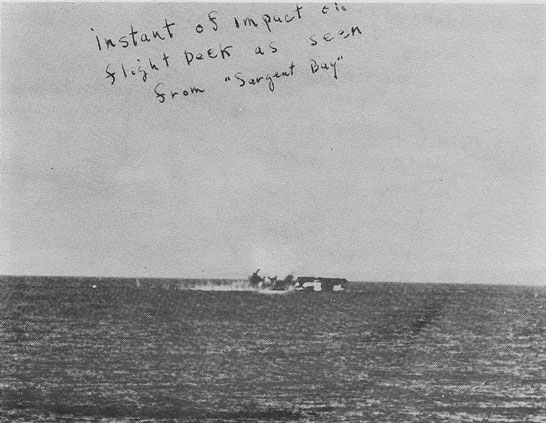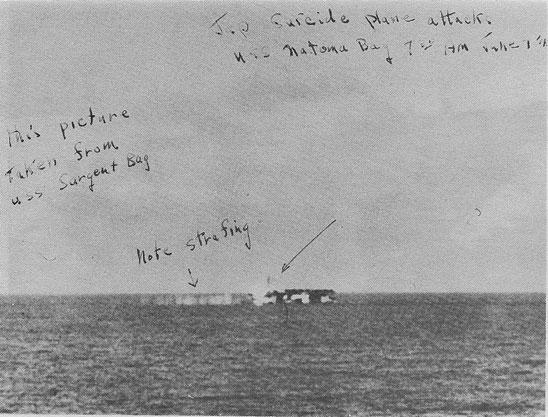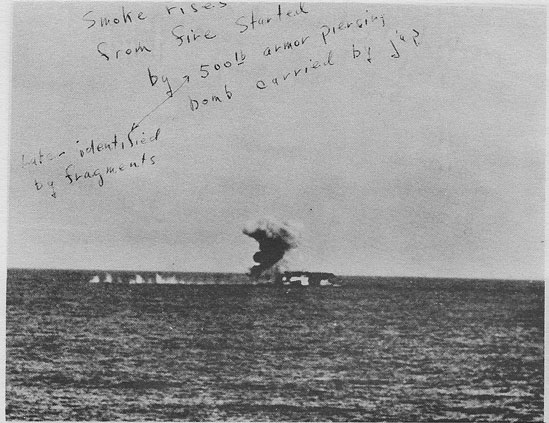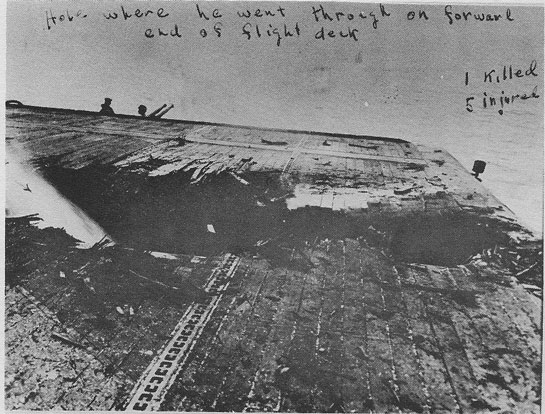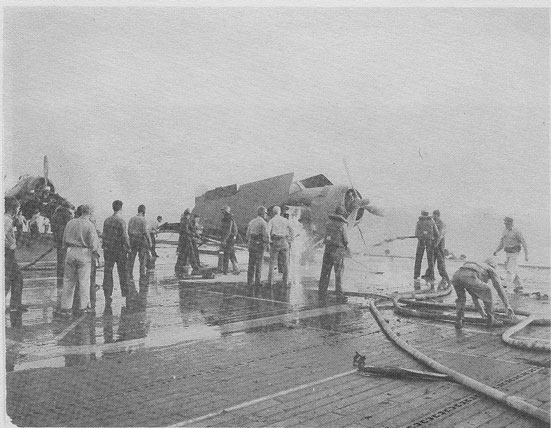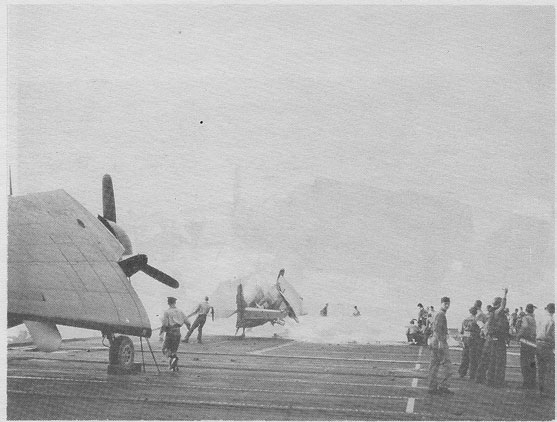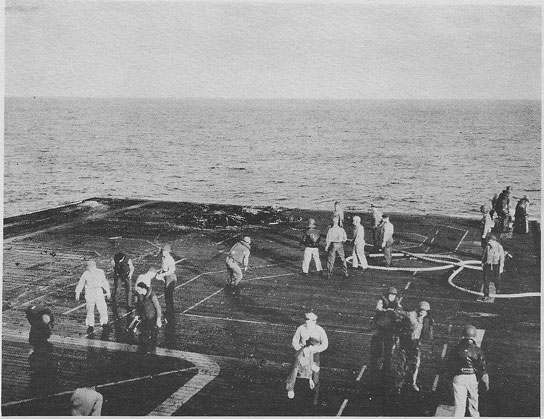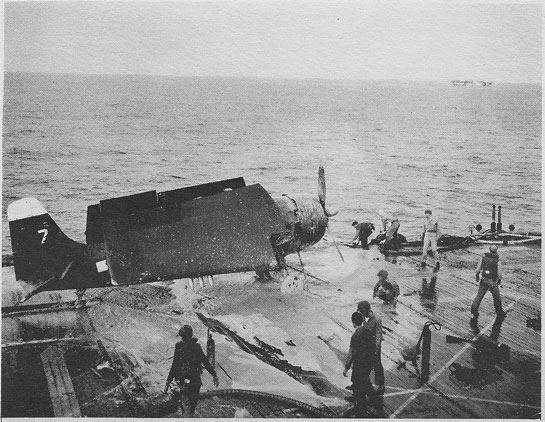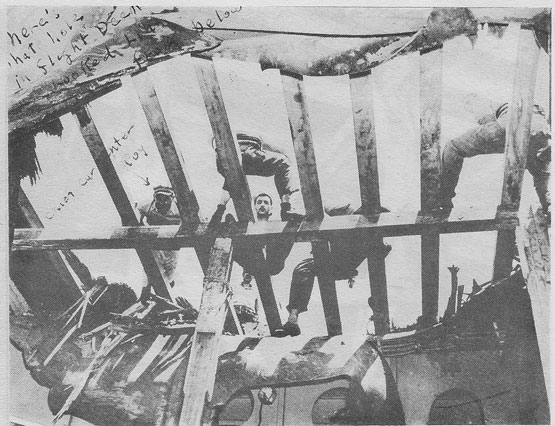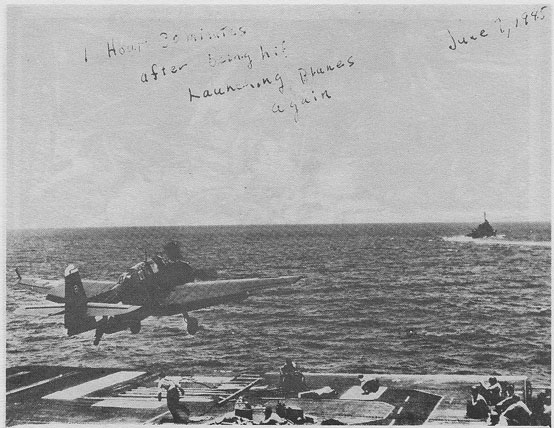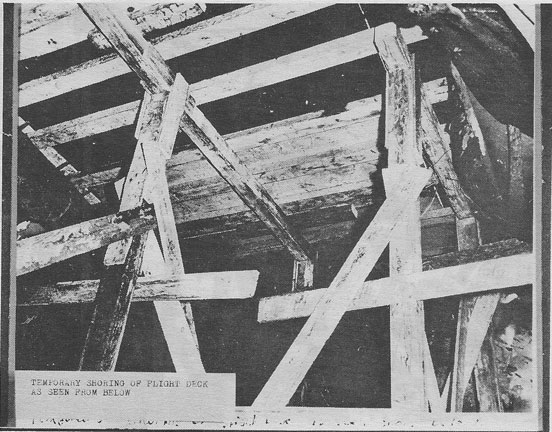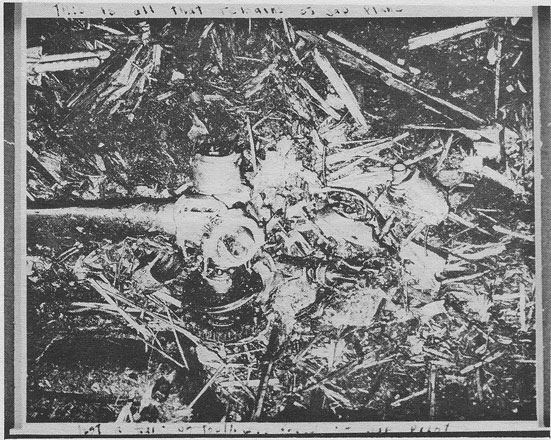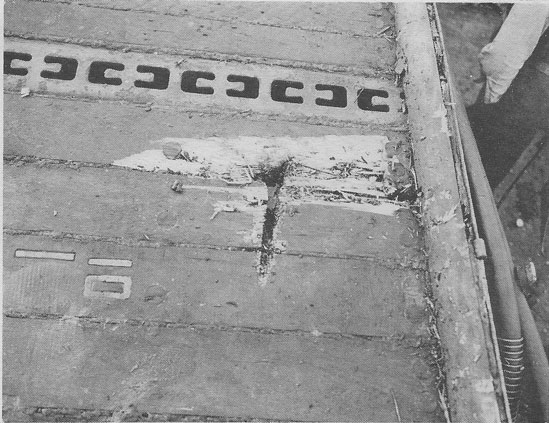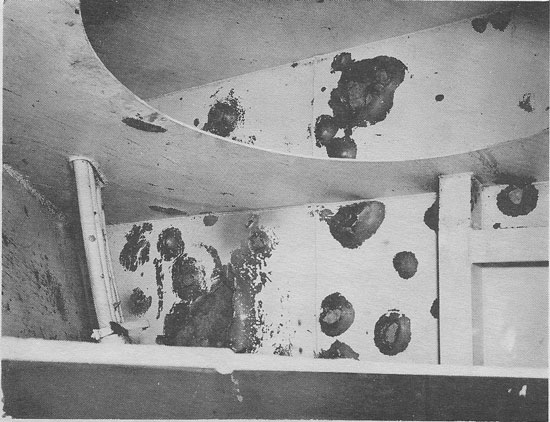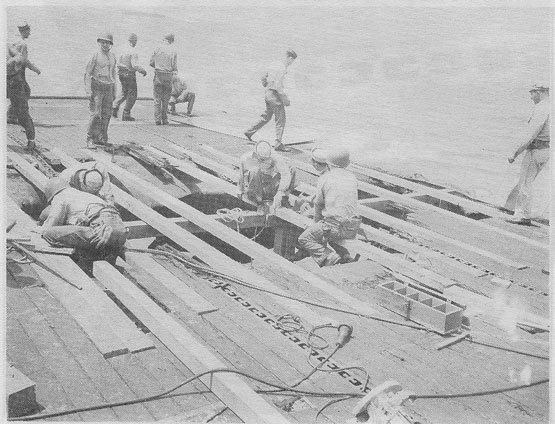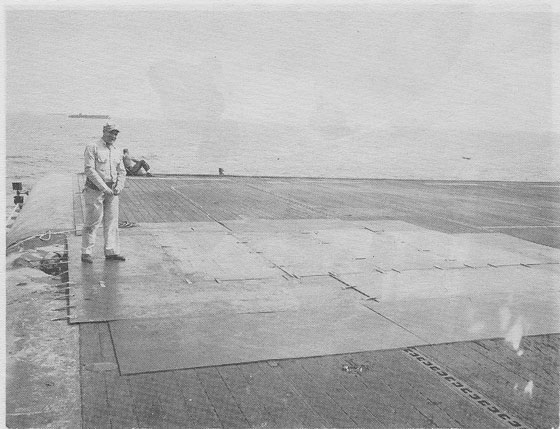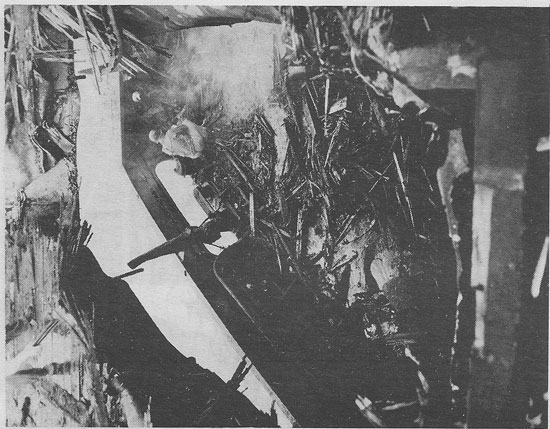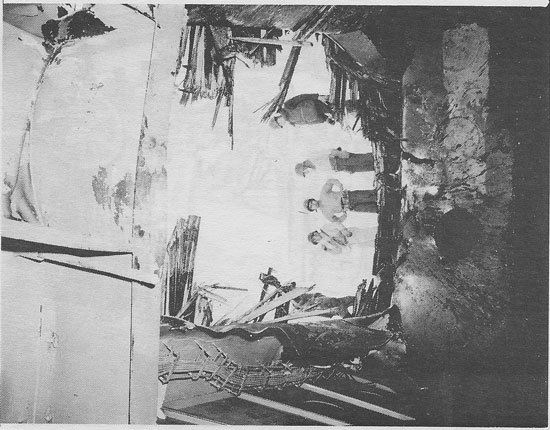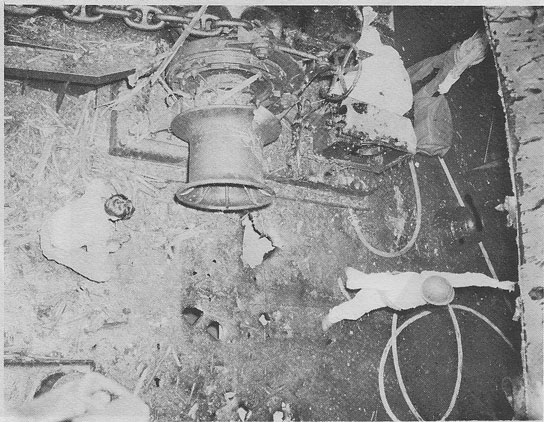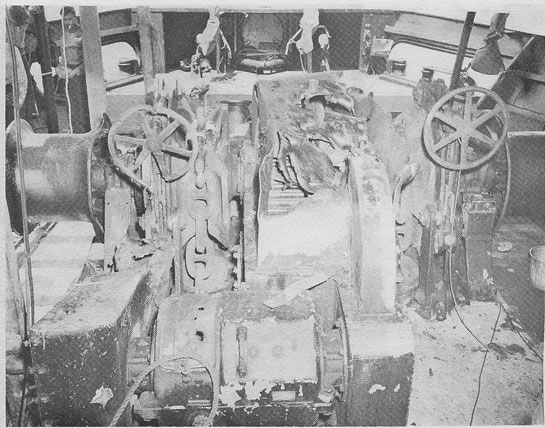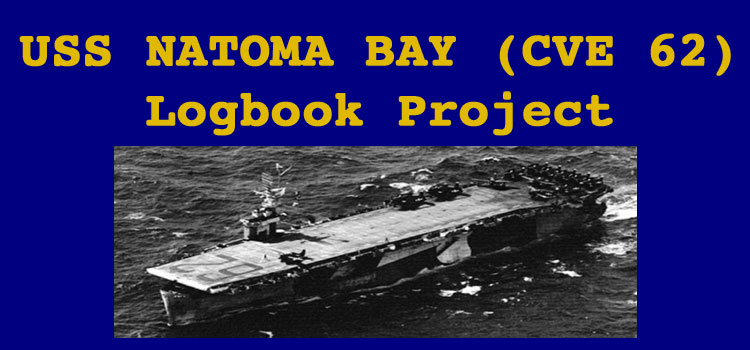Okinawa
Table of Contents
- The Okinawa Campaign—Introduction and page from Natoma Bay War Diary 1 April 1945
- from Action Report - Okinawa Gunto - Part III - Chronology of Operation 1 April 1945
- Additional reports
- Natoma Bay War Diary 7 June 1945
- Photos (from Logbook - Okinawa - Miyako Shima pp. 17-26)
THE OKINAWA CAMPAIGN
The Okinawa Campaign is regarded as the greatest sea-air battle in history (1 Apr.-22 June 1945).
The greatest naval armada in history: 40 carriers, 18 battleships, 200 destroyers, hundreds of transports, cruisers, supply ships, and more than 15 ships transporting 182,000 assault troops took part in the assault on Okinawa, called Operation Iceberg.
NATOMA BAY with squadron VC 9 left Ulithi lagoon 21 March to join the preinvasion group bombarding Kerama Retto 24 March - 1 April. After which she shifted to Okinawa. This was to be the battle of superlatives. In size, scope, and ferocity it dwarfed the Battle for Britain.
Never before had there been, probably never again will there be, such a vicious, sprawling struggle of planes against planes and ships against planes. The final toll of American casualties was going to become the highest ever suffered in any campaign against the Japanese. We were to have casualties of 75,000 men - 12,000 dead, the rest wounded and missing - 4,000 Navy men are to die. The Japanese were to lose 110,000, 7,400 to surrender - 16 combat ships, 7,830 planes. Navy and Marine planes accounted for 3,047 and 409 were shot down by ships' guns.
The kamikazes accounted for the largest amount of Navy casualties. Their attacks reached every type of ship, but never sank anything larger than a destroyer. Suicide planes from Japan kept the entire U.S. Fleet on constant alert.
Easter Sunday - 1 April - The Third and Fifth Fleets cruise off shore - famed Task Force 58 under Marc Mitscher is to the north and east of Okinawa, to the southeast are 17 U.S. Jeep Carriers furnishing air support for the ground troops ashore, and flying combat air patrol for the surface ships. Cruisers and battleships steam back and forth within easy range of Okinawa's high escarpments shelling Japanese positions. This is the story of the 86 days we spent at Okinawa as part of the "Fleet That Came to Stay."
After expending the ship's aircraft ordnance material on preinvasion bombing of Kerama Retto, we needed ammo replenishment - Kerama Retto anchorage now being secured, we steamed for there early in the morning of 1 April. Here is a page out of NATOMA BAY's war diary:
1 April 1945
T.U. 52.1.1
C.T.U. 52.1.1 Admiral C.A.F. Sprague, USN, in USS FANSHAW BAY, flagship.
1. Task Unit 52.1.1 presently supporting the troops ashore on Okinawa, is composed of the following carriers: MAKIN ISLAND (CVE 93), FANSHAW BAY (CVE 70), NATOMA BAY (CVE 62), STEAMER BAY (CVE 87), LUNGA POINT (CVE 94), SAVO ISLAND (CVE 78), ANZIO (CVE 57) and 14 screening vessels.
2. At 0530 left the formation and proceeded toward Kerama Retto anchorage to replenish ammunition. TABBERER (DE 418) and KELLER (DE 419) escorted.
3. Morning general quarters from 0527 to 0627.
4. General quarters 0826 to 0935 while entering Kerama Retto anchorage.
5. Passed entrance net buoy at 0918 and anchored in berth K-99 at 0949.
6. Replenished ammunition supplies from 1000 to 1840.
7. underway from berth K-99. General quarters while leaving the anchorage from 1843 to 1901. Passed entrance net buoy at 1858.
8. At general quarters at 1915 due to a "flash red" from SOPA Kerama Retto. Observed AA fire over Tokashiki Shima at 1915, continuing until 1930. At 1930 observed flame on water in anchorage. Flame expired in less than 1 minute. This was later determined to have been caused by a suicide plane striking the WEST VIRGINIA (BB 48).
9. There were no flight operations.
back to topFROM ACTION REPORT - OKINAWA GUNTO - PART III - CHRONOLOGY OF OPERATION
1 April 1945
Preceded by intense naval and air bombardment the Tenth Army landed over the Hagushi beaches on Okinawa against light enemy resistance. The assault waves, embarked in LVT's and LVT(A)'s, hit the beach at 0830, moved rapidly inland, and by 1230 had captured both Yontan and Kadena airfields with light losses to our forces. During the landing sporadic mortar and artillery fire fell on the beaches, but no LVT's were lost as a result of enemy action. The boats received very little enemy fire, the ships none, and no mines were found on the beaches. Tanks of the XXIV Corps and III PhibCorps were landed prior to noon and spearheaded the attack against meagre and ineffective resistance throughout the day. Prior to dark, the Tenth Army, with approximately 50,000 troops ashore, had gained a beachhead of 4000 to 5000 yards in depth, secure from small arms fire. All assault division reserves were landed and the reserve of the III PhibCorps and XXIV Corps were ordered to land at 1050 and 1115, respectively. The troops landed during this period included eight assault RCT's, each with one field artillery battalion, two medium field artillery battalions and approximately 15,000 service troops. At 2120 the 7th InfDiv reported finding six piloted bombs or rockets in their zone and the XXIV Corps JidPOA Team was ordered to investigate. A number of undamaged Japanese planes were also captured near Yontan airfield. The 420th FA Group, in firing positions on Keise Shima with two battalions 155mm guns, supported the attack on Okinawa. These battalions received heavy enemy artillery fire during the early morning hours which stopped unloading operations for four hours but caused no damage. At 0730 the XXIV Corps assumed control of the 420th FA Group. By 1600, all units, equipment and supplies of the Keise Shima force completed landing, except 30 percent of the bulk cargo of the 420th FA Group. A liaison plane strip was reported in operation on Keise Shima at 1500. Intensive patrolling of Kerama Retto uncovered little enemy activity.
Elements of the Joint Expeditionary Force less units already present at Kerama Retto and off Okinawa moved into scheduled positions prior to daylight. At 0545 HINSDALE (APA 120) with the Demonstration Group off southeastern Okinawa beaches struck either a torpedo or mine. Engine rooms flooded. Troops were transferred to LST's and transports. HINSDALE was towed to Kerama Retto for unloading into PITT (APA 223). About the same time, LST 884 also with Demonstration Group was hit by suicide plane and burned extensively. Her troops and casualties were transferred to other ships and she was towed to Kerama Retto. A considerable quantity of supplies and equipment belonging to 2d MarDiv was lost. Estimated casualties from LST 884 and HINSDALE were 7 KIA, 18 WIA, 27 MIA. Pre-HOW hour bombardment was conducted as scheduled. By 1000 a total of 10 Shore Fire Control Parties had established communications ashore and were controlling call fire missions. ARKANSAS engaged in fire support mission was fired upon by enemy coast defense gun. MARYLAND immediately directed heavy counterbattery to the area and silenced the gun. At 0600 ADAMS (DM 27) was hit on the stern by suicide plane which inflicted steering casualty and major damage to several compartments. No casualties were reported. ADAMS proceeded to Kerama retto for repairs. LST 724 received slight damage from suicide near miss during the morning. At 1030 LCI(M) 807 had a mortar explosion aboard during fire support mission and suffered 1 KIA and 11 WIA. WEST VIRGINIA remained fully operational after being crashed by suicider about 1915. Fire was started but quickly controlled. Casualties were 4 KIA, 22 WIA. At 1910 ALPINE off western beaches was hit by suicide plane which tore a hole in her starboard side 30 x 30 feet from main deck to waterline. Dangerous fire was ultimately controlled. Emergency repairs are being effected. At 2200 VAMMEN struck booby-trapped group of planks and about 15 seconds later an under-water explosion occurred similar to 300 depth charge. Slight damage to starboard shaft. Minesweepers destroyed 2 mines off southern tip of Okinawa. PATTERSON destroyed one floater about 1215 in Lat. 24-15N, Long. 128-46E. Logistics replenishment of all types progressed favorably at Kerama Retto. General unloading was accelerated and schedule to continue throughout the night. Vessels not required at the objective retired for the night.
Direct air support of troops was furnished by CVE's of TG 52.1 and fast carriers of TG's 58.1, 58.3, and 58.4. More than 500 were engaged in troop support missions between 0700 and 1000. Search flights were made to the north by PBM seaplanes from Kerama Retto. Marine garrison squadrons embarked in CVE's were ordered forward from Ulithi. At 2109 ASP plane from CHANANGO reported ditching about 75 miles south Zampa. Search by DD at night and PBM by daylight was negative.
At 0845 TBM from ESSEX crashed near Zampa due to enemy AA fire. MUSTIN rescued two of crew. At 0925 FM from SAGINAW BAY crashed in flames inland from landing beaches cause unknown. No survivors. Nine F4U's from INTREPID on direct support missions at 0800 carried 11 3/4 inch rocket, "Tiny Tim", for its first combat use. Anti-submarine patrol, five sectors were flown by PBM planes from Kerama Retto. NEW MEXICO OS2U crashed near Kadena at 1036 cause unknown. TBM from CABOT crash landed near Nakagusuku Wan at 1109 after being hit by enemy AA fire. Crew got out of plane, carried life raft to shore line, embarked and paddled to sea. Four fighters covered their movements. Dumbo PBM plane, airborne at that time, landed at Nakagusuku Wan at 1210 and rescued all personnel. Special search was made by PBM in sector 140 to 150 degrees for 500 miles to locate a storm. A PB4Y photographic plane from VD 5 Squadron took still and motion pictures of the landing. Propaganda were dropped. From 0200 to 0500 enemy planes approached from the north. One Zeke was shot down by WICKES at 0442. One unidentified was shot down by BENNION. Total of 9 enemy planes were shot down by VF(N) from fast carriers (TF 58). From 1800 to 1930 1 April to 0700 2 April enemy planes approached from the north and south in 11 raids and many single attacks. Six enemy planes were shot down by gunfire, five enemy planes were shot down by VF. One Oscar landed on Yontan during the night 1 April. Pilot apparently did not know field had been captured. Made normal approach and landing; taxied plane to line and was shot by Marine upon climbing out of plane.
Beach condition were found to be suitable for unloading, and by nightfall sufficient armored units, field artillery units and supplies were landed to support the night defense of the beachhead and to provide support for the continuance of the attack 2 April. LST' s and LSM' s were landed at a number of points along the reef.
Weather: Overcast. Winds from E to NE at 5 to 7 knots. Visibility 5 to 7 miles. Temperature 73 degrees. Slight sea, no swell.
(End excerpt from Action Report)
back to topAdditional Reports
A forecast of the terror impending at Okinawa has touched the invasion fleet even before the first landings. INDIANAPOLIS, the flagship of the armada under Admiral Spruance is hit by a kamikaze. ADAMS, MURRAY, and the Sweeper SKYLARK are disabled and head for Kerama Retto, already beginning to pile up with limping and crippled ships. Between 23 March and 17 May, 156 ships will be damaged by enemy action. Of these will be 7 battleships, 2 heavy cruisers, 2 light cruisers, 3 CV's, 2 CVE's, 38 DD's, 5 DE's, 20 transports, and the rest were landing craft of all varieties. Our old friend WEST VIRGINIA was to remain fully operational after suffering 4 killed and 22 wounded.
7 April turns out to be a very eventful day. The ammunition ship LOGAN VICTORY is crashed by 2 suicide planes and dies in an awesome display of pyrotechnics. Another ammunition ship is sunk and an escort ship is damaged by Japanese swimmers pushing planks loaded with explosive charges. The Super Battleship Yamato is sighted on this day and planes from TF 58 send 10 torpedoes and 5 bombs into her before she slides under. With her go the light Cruiser YAHAGI and 4 destroyers. The Big E and ESSEX are damaged, and many DD's and DE's are hit, in one of the most sensational of the suicide sacrifices in the defense of Okinawa.
April 12, the day of President Roosevelt's death, is a day of the great attack. At home a nation mourns, at Okinawa the news spreads from foxhole to foxhole, from flight deck to gun turret, but there is no time to mourn, no time to pray. This same day many another American is to die.
In the clear bright afternoon perhaps 175 enemy planes in 17 separate raids reach the Okinawa area. They are met by our combat air patrol and the guns of the most powerful fleet in history, yet they exact a grim toll. The picket line, those gallant destroyers take the brunt of it. The "Cassin Young" splashes four Vals before taking a hit on the forward engine room. Her casualties were 1 dead, 54 wounded. The MANNERT L. ABELE is crashed by a Zeke, which breaks her back and stops her shafts. She lays dead in the water is struck by a Baka bomb.
This new weapon, first used at Okinawa was a tiny glider, piloted by a suicide pilot and carrying a 2,645-pound warhead. It is launched from a bomber and speeds to its target at 500 knots, The Baka strikes "Abele", the dying ship breaks in half, resulting in 6 killed, 24 wounded, and 74 missing.
The battleship TENNESSEE is hit, blisters on the IDAHO are flooded and the NEW MEXICO is hit by a shell from a shore battery.
Tokyo Rose expresses regret at the tragedy of Roosevelt's death and claims we will all join him soon because 70% of the great U.S. Fleet is lying on the bottom around this island.
April 15-17 is another bad period. The destroyer LAFFEY in picket line #1 survives 80 minutes of unparalleled horror - some 50 planes show up on her radar simultaneously. Some are shot down by our CAP but as she fights off 22 separate attacks from all quarters, she is crashed by six suicides and takes four bombs. She manages to shoot down nine and miraculously lives to tell about it due to her skipper's superb ship handling. When it was all over she limps into anchorage in tow with 31 dead, 72 wounded, and only four 20mm. guns still operational.
On this day the carrier INTREPID is hit, one of her escorts is sunk and many others damaged. Picket lines 1, 2, 3, and 14 are given a standing CAP to provide relief from the skill and effectiveness of the suicide planes, and to employ all available means to prevent further attacks on the pickets.
As damaged ships clog the anchorage at Kerama Retto, there is also a trail of limping and crippled ships all the way across the Pacific. The fire-gutted FRANKLIN even transits the Panama Canal on its way to New York.
But the traffic across the Pacific is two way. The crippled steam home and replacements of flesh and steel move west to replace these.
Gone now are the hopes for a quick victory at Okinawa. The last great battle of World War II. By the end of April, 20 U.S. ships have been sunk and 157 damaged - mostly by suiciders. The "Fleet That Came To Stay", the battleships, the cruisers, the destroyers, the jeep carriers still steam off the island and day after day carry out their assigned jobs of supporting the troops ashore.
Natoma Bay is participating in her second of the ten greatest battles in history, the other being the Liberation of the Philippines. She is destined to see many of her group come and go during the long and perilous assault on Okinawa. Luck, the Grace of God, and her combat readiness is a determining factor in allowing her to survive the entire campaign.
Although we are not to emerge unscathed, we are to be fortunate enough to support and survive the entire campaign from pre-invasion to security of the island.
With the end of April 1945 drawing near, there is no let up in the suicide attacks on the American fleet. The terrible battle is destined to drag on for almost two more months. The strain of waiting, the anticipated terror, made vivid from past experiences sends some men into hysteria and breakdowns - only the saving trait of the great American sense of humor keeps most from the brink of insanity.
In one instance, an American gunboat, fed up with close brushes with death, rigs up a huge sign with an arrow, which reads "Jap pilot, this way to Task Force 58".
Still the low-quarter fight goes on. Joining the harassment of the fleet are submarines, suicide boats, and midget submarines.
Now in May, the two admirals who have commanded the greatest land, sea, and air battle the Americans have ever fought, turn over command to "Wild Bull" Halsey and John S. McCain, the tobacco-chewing admiral. They are to have their problems too. The Third Fleet is experiencing alarming losses of ships on the picket lines. On 3 June the kamikazes come again in force, this time with 75 planes in 18 separate raids. On 4 June nature joins the malevolent forces of the Japanese. A typhoon with its gigantic waves strikes the fleet, tossing ships like so many chips. The bow of the cruiser PITTSBURGH is sheared off, the carrier HORNET and many other ships are severely damaged. On 5 June the battleship MISSISSIPI and the cruiser LOUISVILLE are struck by suiciders.
On 6 June the raids are still heavy from the north. The enemy is dying hard; the end is almost in sight.
On 7 June we are to experience one of our most unforgetable days - here then is that day as recorded in the history of the USS NATOMA BAY:
At 0635, 7 June, after having maneuvered through typhoon weather, NATOMA BAY was closed by a Zeke, broad on the port quarter and low on the water. Changing course, it came in over the stern, fired incendiary ammunition at the bridge, and on reaching the island structure, nosed over and crashed into the flight deck. The engine, propeller and bomb tore a hole in the flight deck, 12 by 20 feet, while the explosion of the bomb damaged the deck of the foc'sle and the anchor windlass beyond repair and ignited a nearby fighter. Three of the CVE's crew and one officer of VC 9 were wounded. One ship's officer was killed. A second Zeke was splashed by the ship's port batteries. The damage control party immediately extinguished the blaze and set about emergency repairs. The next strike was canceled, but the following one against Miayako Shima, took place as scheduled at 1030.
Some statistics uncovered while researching the battle for Okinawa will point out why this was the greatest air-sea battle in history. Suicide attacks occurred as follows: the largest was on 6-7 April, 355 kamikazes of which 230 were Jap navy planes and 125 were army; on 15-16 April there were 165 attacks; on 27-28 April 150; on 10-11 May 140; 23-24 May, 165; 27-29 May, 110; 7 June, 50 (when we were hit). The total number of suiciders was 1900 planes - 1050 navy and 850 army. The sources were mainly from Kyushu with some from Formosa.
The kamikaze that hit the Big NB probably came from Formosa or an underground hangar on Myaka Jima. At the time we were hit, we were were relieving a British unit that had gone out of the area to refuel. We had been assured that the area was quiet and we should expect no trouble. How unprophetic!
After our escapade at Sakishima (Myaka Jima) Natoma Bay returned to her duties of supporting the troops ashore at Okinawa and flying our CAP and ASW patrols. On 24 June we were to leave the area and steam for Guam for repairs. No mention was made of retirement from the forward area and a return to the States. We were all pretty sure that with a new flight deck and a new camouflage paint job that our next destination had to be Japan itself.
back to topUSS NATOMA BAY (CVE 62)
c/o Fleet Post Office
San Francisco, California
Subject: War Diary.
7 June 1945
1. Proceeded with T.U. 32.1.1 in cruising disposition 5RM for 7 carriers with the following stations:
NATOMA BAY (CVE 62) #1
LUNGA POINT (CVE 94) #2
SARGENT BAY (CVE 83) #3
WAKE ISLAND (CVE 65) #4
SHAMROCK BAY (CVE 83) #5
MEHENTA BAY (CVE 74) #6
HOGGATT BAY (CVE 75) guide and center
Fleet axis was 000(T). Cruised in vicinity of a point approximately 58 miles east of Miyako Shima and struck Hirara Airfield on Miyake Shima while other planes of the unit struck other airfields and targets of Sakashima Gunto. In the early morning, this ship sustained an attack by what was believed to be a Zeke Kamikaze which caused the death of one officer of the ship's company, serious injury to an officer pilot of the embarked squadron, and minor wounds to three men as well as damage to the ship.
2. Flying conditions were average to good through the day, with 15 to 20 mile visibility and high overcast with a 3000 foot broken ceiling.
3. Morning general quarters from 0443 to 0545
4. At 0547 fleet course was changed to 150 degrees (T), and speed to 14 knots.
5. The 0600 position, by observation, was 24-46.1 N., 126-37.3 E. At 0602, the unit commenced zigzagging in accordance with Plan 6.
6. At 0635, while on course 145(T), a Zeke was observed broad on the port quarter distant about 700 to 800 yards and at an altitude of about 500 feet headed toward the ship. The plane made a sharp left turn and came in strafing over the stern in about a 20 degree glide along the axis of the ship and directly over it. The strafing was with incendiary ammunition which damaged the SK radar antenna and the flight deck. When about abreast of the bridge, and at that level the plane pushed over sharply and crashed into the forward end of the flight deck, just abaft the ramp and between the centerline and the catapult track. The plane disintegrated upon impact, the wings and fuselage going over the bow while the engine, propeller and bomb continued through to the forecastle. The bomb apparently exploded in the open space between flight and forecastle decks. It is believed that from three to five hits were made by 20mm shells while the plane was closing the ship. During this time, the plane closed approximately 1100 yards, at which distance it banked, belly to the ship, and swung parallel to the ship's course, distant about 1000 yards, at an altitude of 800 to 1000 feet and proceeded on a glide angle of 10 degrees or less. Both the plane which hit the ship and the second plane flew comparatively slowly, at a speed estimated to be about 175 knots.
7. The 40 mm guns fired 56 rounds and it is believed scored several hits. The 20mm guns fired 375 rounds and hit the plane repeatedly during its parallel run and until it was taken under fire by SARGENT BAY, All hits observed were aft of the cockpit or in the starboard wing. One screening vessel fired one or more rounds of 5" AA when the plane had passed ahead of this ship. The plane proceeded ahead of the ship and approached the SARGENT BAY on its port quarter. When broad on SARGENT BAY's port quarter, SARGENT BAY opened fire, maintaining fire while the plane nosed up, banked with its port wing down, and dived into the sea off the port bow.
8. The LCAP, which it is believed the second plane had used for cover in approaching the ship, had meanwhile continued its counter-clockwise circle and departed the scene.
9. The plane which crashed into the ship was not taken under fire. Prior to the attack no bogies had been reported by radar, visual fighter director, lookouts or local combat air partol. There were seven CVE's and seven escorts in the formation.
10. A listing of resultant damage is appended hereto. The officer killed and the officer wounded were on the forecastle deck. A medical report of injuries is attached.
11. The blast and debris from the impact on the flight deck punctured the starboard gas tanks on an FM2 which was spotted on the catapult and set it afire. This plane, with its attendant risk, was quickly disposed of by catapulting it into the sea. The ship went to General Quarters at 0636, immediately following the impact. At 0637, a five plane loose formation was noted about 3000 yards slant range bearing 260 degrees relative, and on a course opposite to ships heading. The leading plane of this formation was examined by the officer on port side gunnery control and identified as an FM2. He then turned momentarily to the lookout watch to check the scanning of sectors. Seconds later, in scanning the other planes, he saw that there were only four planes in the formation and that the fifth and last plane, which had been slightly nearer the observed and somewhat below the others, had peeled off and was in a glide bombing angle of approach on the ship distant about 1500 yards at 800 to 1000 feet elevation and bearing 265 to 270 degrees relative. Immediately thereafter, and before order could be given, various guns opened fire on the attacking plane. Practically the entire port battery opened fire while the plane was within range.
12. Gasoline fires on the forecastle deck were quickly controlled. The 20mm strafing fire had caused smoldering fires on the deck planking where the bullets, apparently incendiary, had penetrated. These were chopped out and repairs were immediately started on the flight deck.
13. One unexplained circumstance, believed to be related to the attacks, is set out here for documentary purposes and for clarification by comparison with other attacks. Just before the attact by the second plane, a column of heavy black smoke was noted about eight miles distant, and 80 to 85 degrees relative. Just after the second plane has passed ahead of the ship, a similar column of smoke was observed at horizon distance at 235 to 240 degrees relative. These columns started within 15 to 30 seconds of each other. No planes, either enemy or friendly, were in either sector before the smoke was sighted. The smoke continued to rise for several minutes from each column, resembling, in each instance, the result of a crashed and burning plane, although no flame was visible. It is possible that this was a part of a deceptive device used to divert attention from the planned coordinated attack. Neither of the planes carried droppable wing tanks when they attacked, nor did they show any bombs.
14. The attack had left a hole in the flight deck plating 12 feet wide, beginning two feet to port of the center line of the deck and extending to port, and 20 feet in depth from a point just aft of the forward end of the deck. This hole was decked over semi-permanently and the flight deck shored up and braced across its entire forward section sufficiently so that it could be used for flyaway and catapult-launches. These repairs were completed by 1500 while the regular operating schedule was resumed two hours after the attack. From recovered fragments, it is believed that the bomb carried was a type 99 Navy SAP 63 kg bomb.
15. At 0848, 8 VF of Strike #1 were landed aboard, at 0906 4 VT of strike #1 were landed, 2 VT of the strike landing on WAKE ISLAND due to the lack of flight deck space occasioned by the repairs in progress. One plane so landing had been damaged by AA fire over Hirara.
16. At 1014, a third zeke approached the formation from out of the sun, which at that time was at 165 degrees relative at an elevation of 55 degrees. The plane circled counterclockwise. It was immediately identified as a Zeke. It circled from 165 to 060, maintaining an altitude of 12,000 to 15,000 feet. Four FM2's were in its immediate vicinity but never sighted it. The plane was out of 40mm range, and on the only occasion on which the 5" gun on the fantail could be brought to bear, the FM2's were too close to the target plane for safe firing. The 40mm guns fired one spotting burst to indicate the planes position to other ships. At 1026 the plane flew into cloud cover and left the area.
17. At 1029 - 6 VT and 8VF were launched by catapult, the flight deck having been sufficiently shored. Repairs continued on the deck during the launchings. The undamaged VT from WAKE ISLAND returned at 1041.
18. The SK radar, partially incapacitated by, strafing, was back in operation at 1503.
19. At 1557, the damaged VT returned to base from WAKE ISLAND, having been repaired.
20. At 1643 secured from General Quarters.
21. JOHN D. HENLEY (DD 553) was alongside from 1828 to 1858 to transfer personnel.
22. Evening General Quarters from 1920 to 2018.
23. At 1955 NEHENTA BAY and RICHARD S. BULL (DE 402) left the formation.
24. Air operations for the day consisted of 55 sorties, launched in four strikes. The target for all strikes was Hirara Airfield on Miyako Shima with its surrounding buildings and installations, Together with any boats or shipping encountered
Launchings were as follows:
8 VF and 6 VT at 0530
8 VF and 6 VT at 1029
8 VF and 5 VT at 1300
8 VF and 6 VT at 1545
In bombing, rocketing and strafing attacks, a radio station was destroyed, 4 barracks building were destroyed and 2 others left ablaze, 1 twin engine and 3 single engine planes were destroyed, two warehouses were left ablaze, 5 metal landing type boats and 5 wooden fishing boats were strafed with unobserved results, Hirara Town was strafed and fired, a lighhouse was strafed and rocketed, the NE-SW runway was hit with 12 - 500# bombs, the E-W runway with 40 - 100# bombs, the N-S runway with 12 - 500# bombs, and the intersection with 4 - 500# bombs and 30 - 100# bombs. All runways were believed to have been left inoperational at the conclusion of the day's attacks.
25. 44 - 500# G.P bombs, 120 - 100# G.P bombs 237 - 5" H.E. rockets and 24,600 rounds of ammunition were expended by planes from the ship and 56 rounds of 40mm and 375 rounds of 20mm AA ammunition were expended by the ship, all in combat.
26. Positions:
0800 Lat. 24 deg 32.5'N, Long. 126 deg 37.0'E
1200 Lat. 24 deg 17.5'N, Long.126 deg 19.0'E
2000 Lat. 24 deg. 52.9'N, Long.127 deg. 08.1'E
back to topPhotos
(from pp. 17-26 of Logbook)
[Editor's Note: These photos, and others, can also be seen at the Natoma Bay Photogallery. ]
